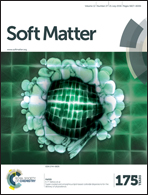Abstract
As a continuation of previous work, the self-assembly process of cationic lipid formulations in the presence and absence of DNA was investigated with respect to binary lipid mixtures suitable as polynucleotide carrier systems. The lipid blends consist of one malonic-acid-based cationic lipid with a varying alkyl chain pattern, either N-{6-amino-1-[N-(9Z)-octadec-9-enylamino]-1-oxohexan-(2S)-2-yl}-N′-{2-[N,N-bis(2-aminoethyl)amino]ethyl}-2-hexadecylpropandiamide (OH4) or N-[6-amino-1-oxo-1-(N-tetradecylamino)hexan-(2S)-2-yl]-N′-{2-[N,N-bis(2-aminoethyl)amino]ethyl}-2-hexadecylpropandiamide (TH4), and one neutral co-lipid, either 1,2-di-[(9Z)-octadec-9-enoyl]-sn-glycero-3-phosphocholine (DOPE) or 1,2-di-(hexadecanoyl)-sn-glycero-3-phosphocholine (DPPC). Although the cationic lipids exhibit only slight differences in their structure, the DNA transfer efficiency varies drastically. Therefore, self-assembly was studied in 3D systems by small- and wide-angle X-ray scattering (SAXS and WAXS) and transmission electron microscopy (TEM) as well as in 2D systems by infrared reflection–absorption spectroscopy (IRRAS) on Langmuir films. The investigated lipid mixtures show quite different self-assembly in the absence of DNA, with varying structures from vesicles (OH4/DOPE; TH4/DOPE) and tubes (TH4/DOPE) to discoid structures (OH4/DPPC; TH4/DPPC). Twisted ribbons and sheets, which were stabilized due to hydrogen-bond networks, were found in all investigated lipid mixtures in the absence of DNA. The addition of DNA leads to the formation of lamellar lipoplexes for all the investigated lipid compositions. The lipoplexes differ in crucial parameters, such as the lamellar repeat distance and the spacing between the DNA strands, indicating differences in the binding strength between DNA and the lipid composition. The formation of associates with an ideal charge density might emerge as a key parameter for efficient DNA transfer. Furthermore, the structures observed for the different lipid compositions in the absence of DNA prepare the way for other applications besides gene therapy.


 Please wait while we load your content...
Please wait while we load your content...